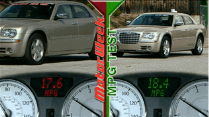 Fuel Economy Focus Fuel Economy Focus
John Davis
The window sticker on a new car contains lots of information besides just the price. For instance, down at the bottom are the all important government fuel economy estimates. But just like the price on the sticker may have little in common with what you actually pay for the car, the mileage estimates may also be far different from real world results. So, why does gas mileage vary so much? Well, the answers are as varied as your mileage.
To find the answers, we devised a simple test: Conduct a fuel economy loop using the same route with two different drivers and driving styles. And thanks to Chrysler, we soon found ourselves in possession of identical-twin 300C sedans, both equipped with the 5.7 liter Hemi V8 with Multi-Displacement cylinder cut-off technology, and EPA ratings of 18 MPG City/24 MPG Highway.
Driving our red-bannered test car, MotorWeek's ace test pilot, Henry Kopacz, was asked to demonstrate the kinds of typical driving behaviors that result in poorer fuel economy, while new U.S. Department of Energy Clean Cities Director, Dennis Smith, agreed to drive our "green" car and offer some tips on improving fuel economy along the way.
DENNIS SMITH: "Just be smooth and drive like your mother is in the car."
Our route contained equal parts country roads, stop and go traffic, and freeways. Drivers took note of fuel economy readings after each leg of the trip, and these CarChip data loggers were used to record information about engine load, throttle position, and rpm directly from the cars' On-Board Diagnostics port.
Starting off, we tackled 30 miles of rural two-lane and country roads. The temptation here was for Henry to let the Hemi loose a little, and use the AutoStick transmission to pick a lower gear for carving corners. Our route had a number of hills to climb, and there's only so much you can do to maximize economy here, the most important being to maintain your momentum. Speeding up a little as you approach a hill will help your car get over the top without working too hard.
Of course, one surefire way to save fuel is to make use of a Park&Ride lot like this one, and carpool to work.
Comparing notes, it's clear that Henry's exuberance cost him, as he ended our first leg with an average of 17.6 miles per gallon. Dennis pulled in with an 18.4 MPG figure, a 4% improvement.
Next it was time to hit the highway, and this is where most of us do our most inefficient driving. Higher speeds and aggressive driving are all highlights of a normal day's commute. Just "going with the flow" these days can mean traveling 10 or 15 miles per hour above the speed limit, and that alone can rob your fuel economy by up to 20%.
Weaving in and out of traffic, not using the highest gear, jumping on and off the throttle, and generally not keeping a steady-state speed are also shortcuts to the nearest gas station.
On the highway, our drivers returned a high average MPG of 24.4, and a low of just 17. That's a 43% difference! Here efficient driving works out to be an extra 140 miles of range per 19-gallon tankful.
We then wound up our test with a stretch of stop and go traffic. Again, our mileage was closer, but Henry's aggressive technique still cost him a 2-1/2 MPG penalty.
SMITH: "We've got some pretty heavy traffic here, so I'm just trying to keep a good following distance so we don't have to make any emergency stops."
The trick to efficient in-town motoring is to drive smoothly, maintain momentum, avoid quick starts and hard stops, always combine short trips, and plan your route to avoid backtracking, congested areas and hills. And don't rely upon your navigation system to do that for you.
Slow down well in advance of red lights rather than driving right up to them. The fewer times you have to accelerate from a complete stop the better your mileage will be.
So, how did we do overall? How does saving 20% on every fill-up sound? That's more than enough to overcome recent gas price hikes, and it's as simple as changing the way you drive.
No matter where you drive, there are some simple things you can do now to increase your fuel economy: First, check your tire pressure regularly. Just one psi under-inflated can reduce fuel economy by 3%. Second, get the junk out of the trunk. Those golf clubs, mega-size toolkits and bags of traction salt are forcing your engine to work harder than it should. Keep your car tuned up. A well-maintained car will run more efficiently. And finally, commit to driving less often. Carpool to work or school, and consider walking or biking for short trips.
Getting the most economy out of your car just makes sense, and the rewards go way beyond mere dollars and cents. Driving smart is a decision that we all can live with. So, step off the gas, and take a stride towards efficient motoring!
|